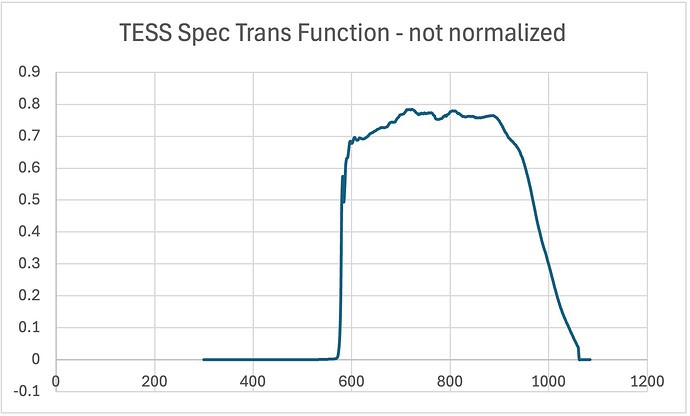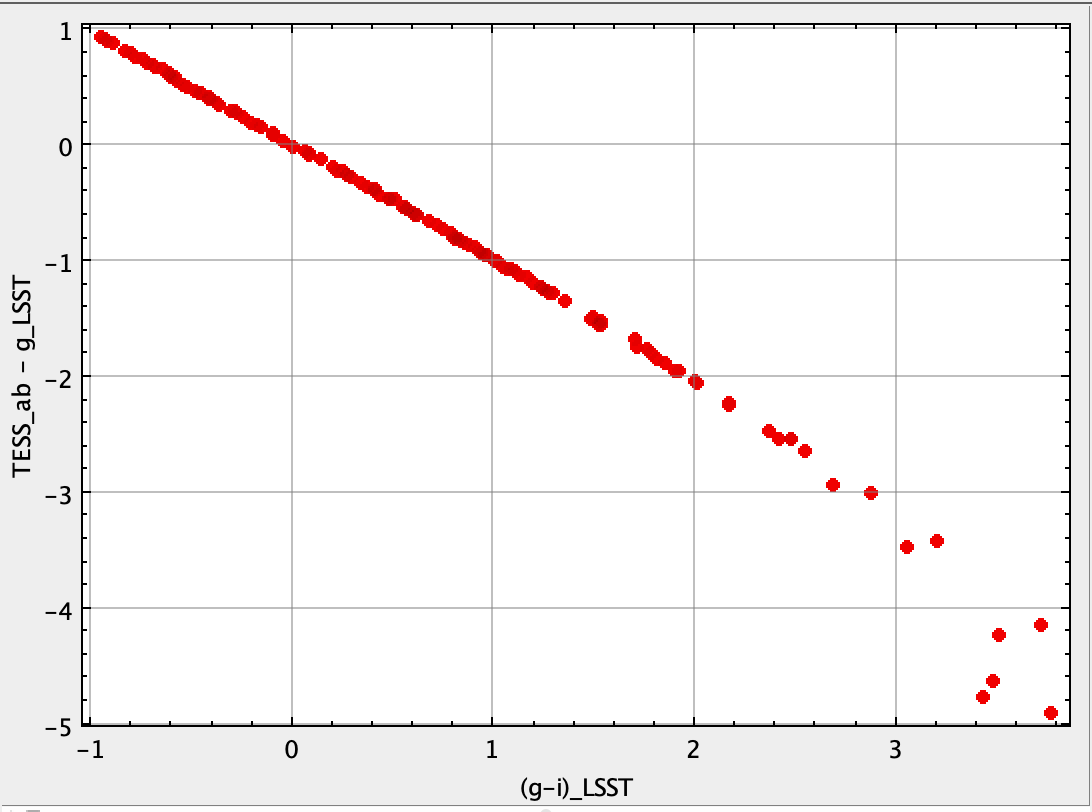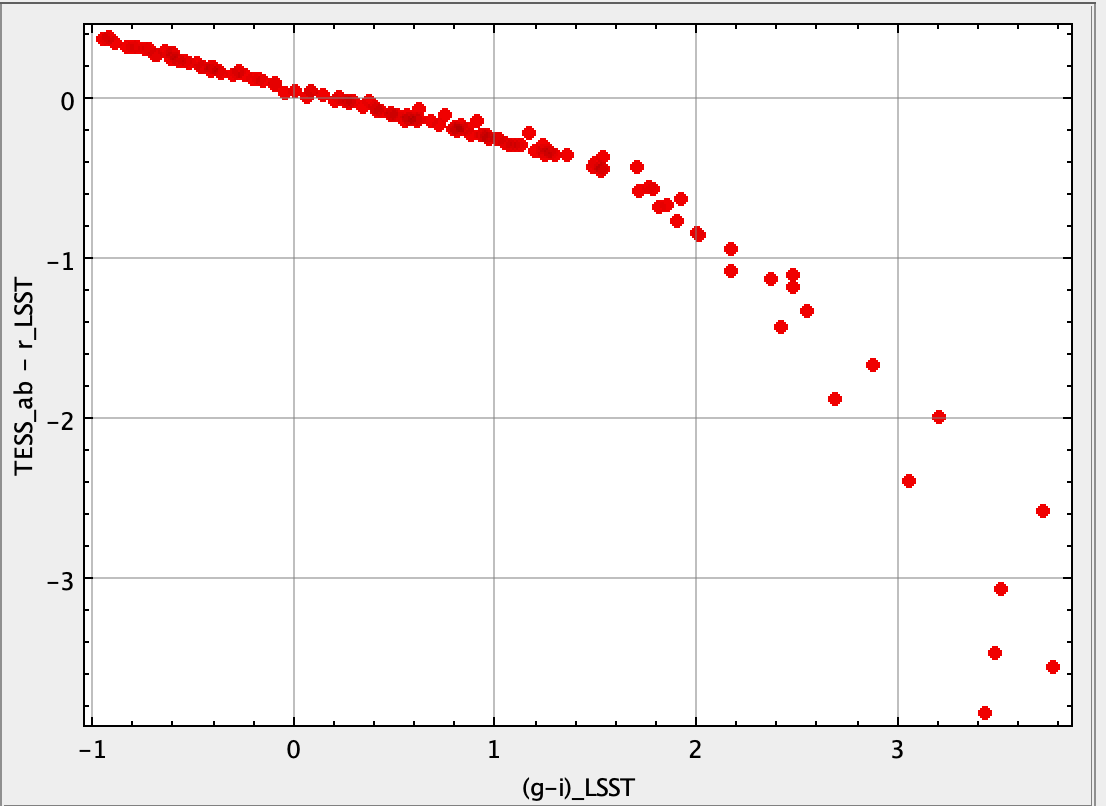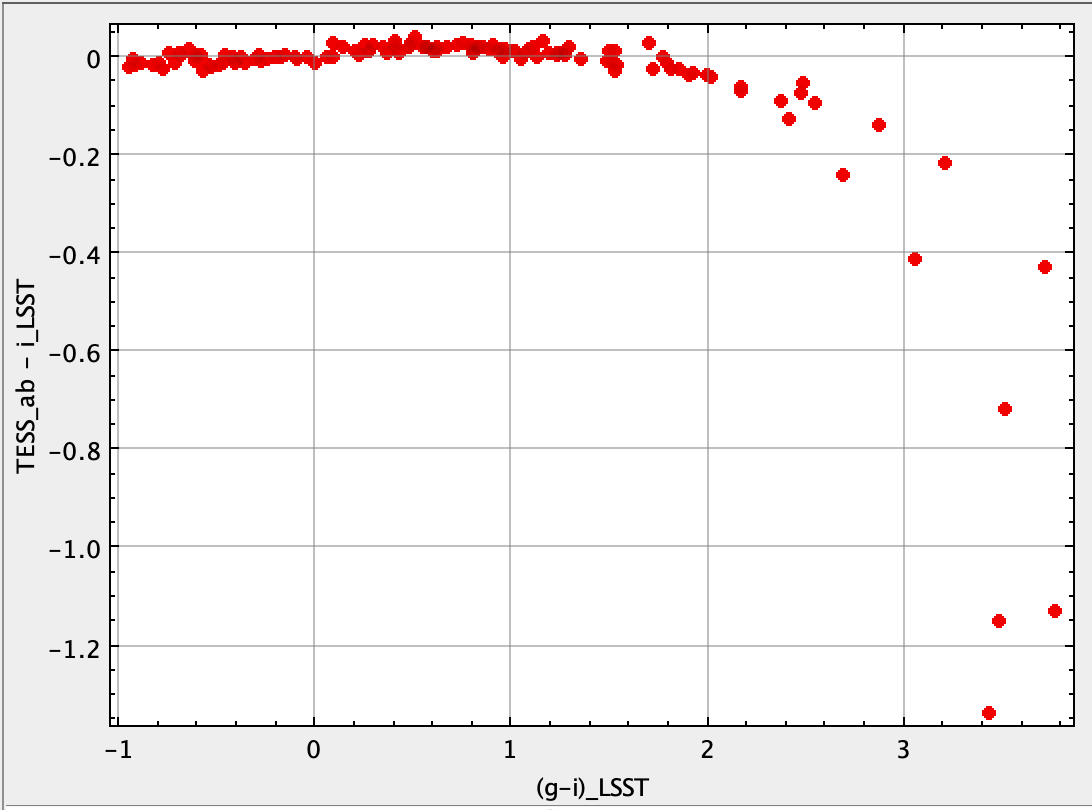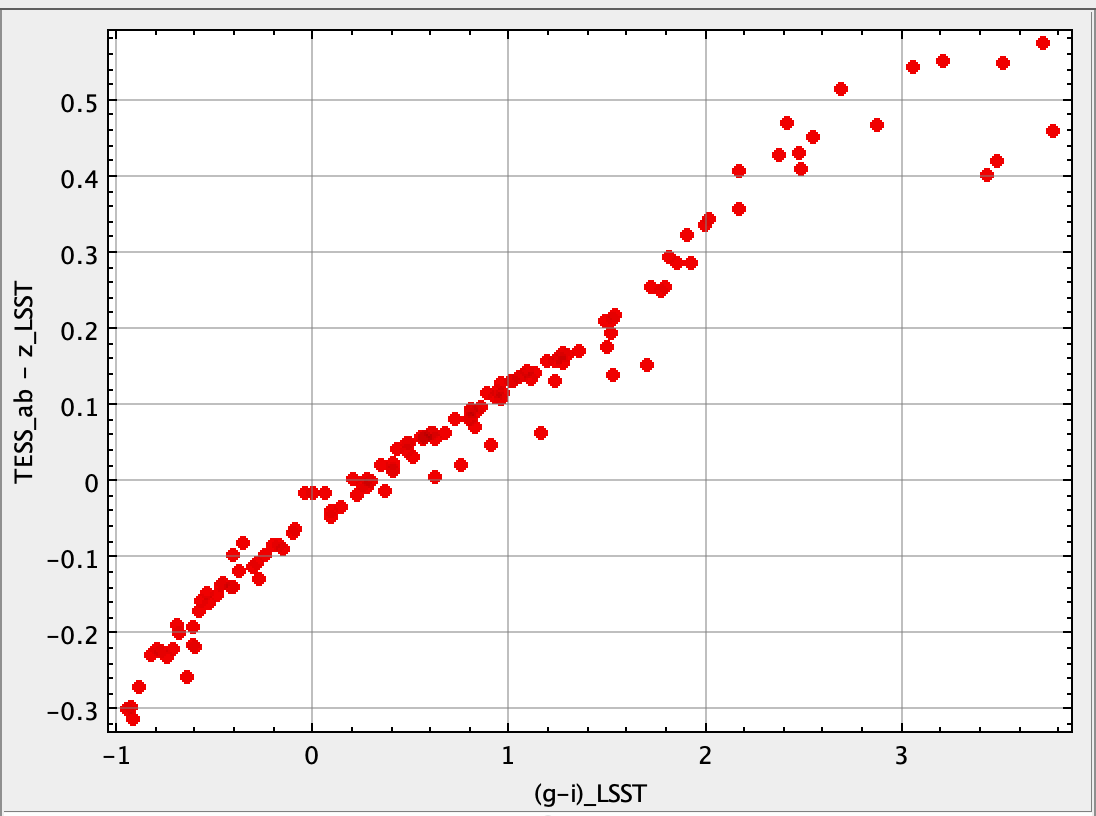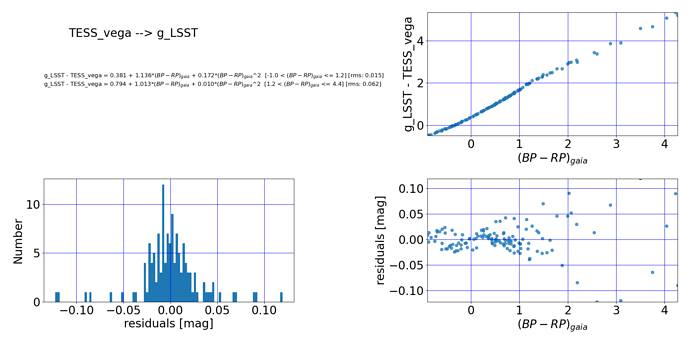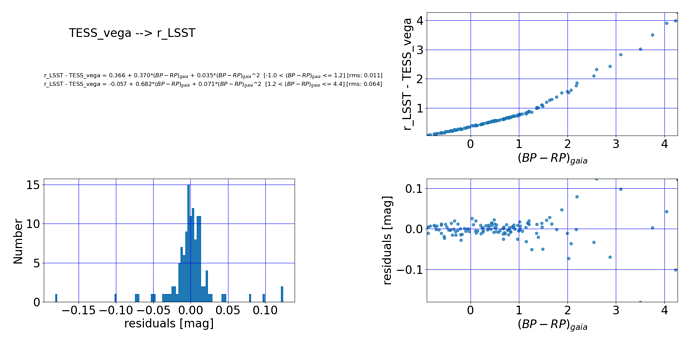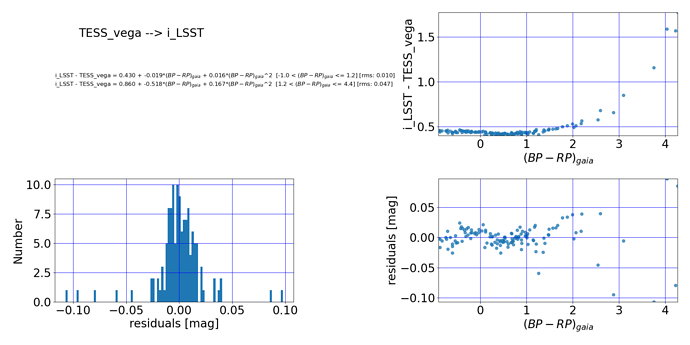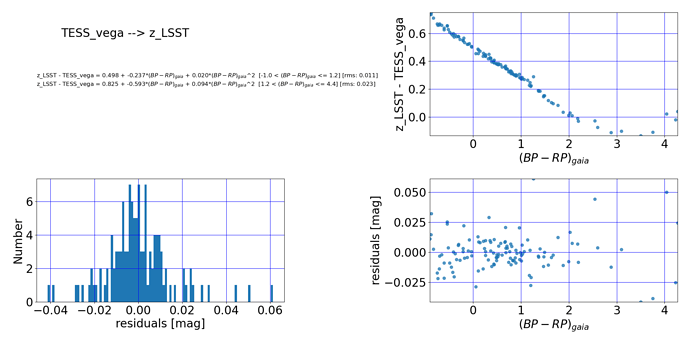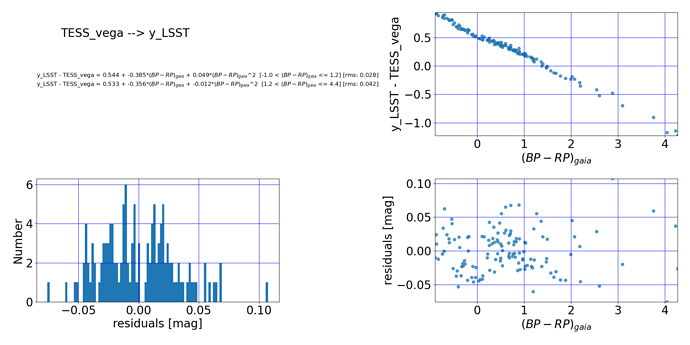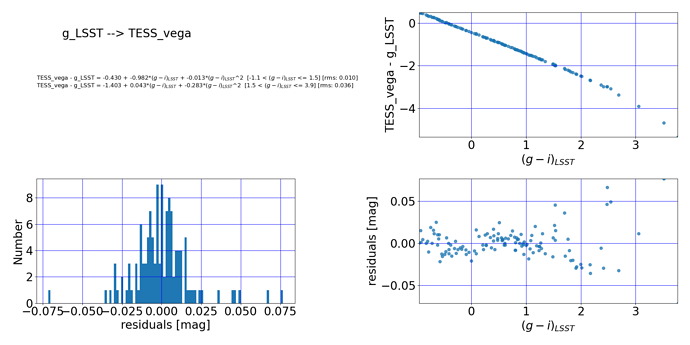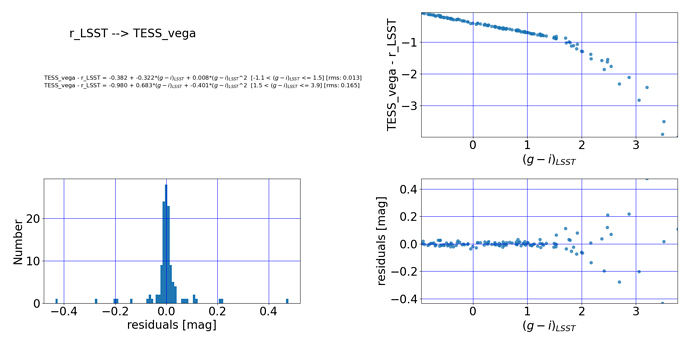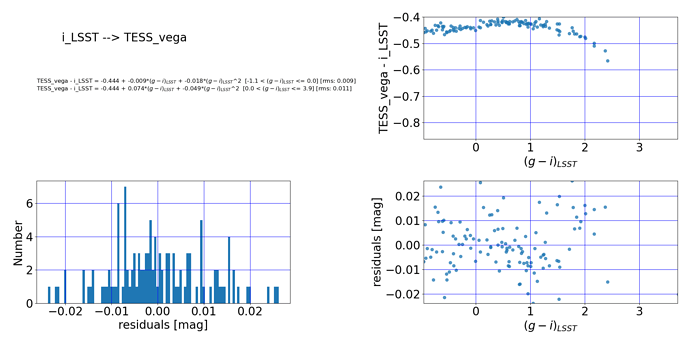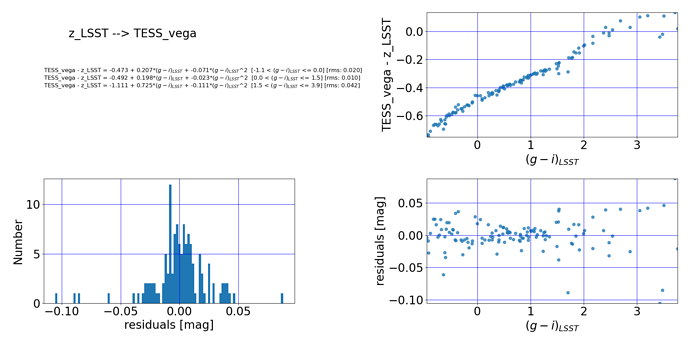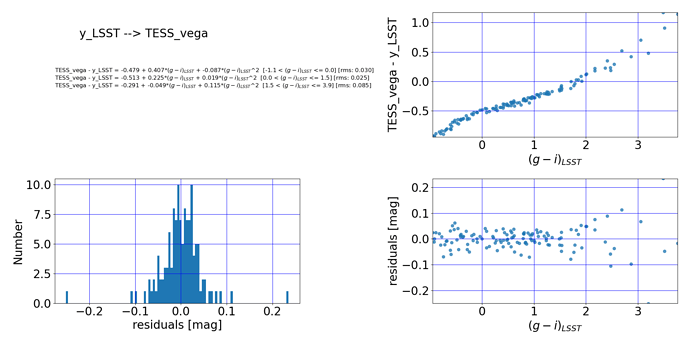I am interested in taking fluxes from TESS objects which are through a single bandpass, and transforming them into fluxes through the appropriate LSST filter bandpasses. Does
anyone have any thoughts on whether this can be done and if so, how to do it?
Dear Don,
Yes, calculating transforms between the LSST filter bandpasses and the TESS bandpass is indeed possible. Since we do not yet have actual LSST on-sky data yet, we would need to create a sample of synthetic photometry in the 2 photometric bandpass systems from a spectrophotometric library, like that of Pickles (1998). I have some code on GitHub which can be of use. It is a set of Jupyter notebooks that convert to/from the Dark Energy Survey grizy system, but can be converted to use with the LSST ugrizy system. They are here: GitHub - DouglasLeeTucker/TransformEqns: Code for transforming between astronomical photometric equations . If you would like some help with this, we have drop-in office hour help sessions every other Thursday at 9AM US Pacific Time (see: DP0 Delegate Assemblies Schedule — DP0 the next drop-in session is this coming Thursday, November 21), or, if that does not work for you, we might be able to arrange something separately.
Thanks!
Thanks Doug, we will take a look and get back to you; much appreciated.
Dear @dkw , could we mark Douglas’s response as the solution for this post? Feel free to follow up if you still have questions!
Hi @dkw! Thanks for your interest in this topic. We are wondering if we can mark Douglas’s response as the solution? If yes this will help other users with a similar question, please let us know!
Hi everyone, my apologies, this dropped off my “radar screen” and I am only now getting back to this part of our project. Let me start over. Doug, at the AAS meeting in January I visited with Meagan Porter and your team’s poster on DEC to LSST using Pickles. After that I got sidetracked and only now am I getting back to this.
What we want to do is take fluxes from RR Lyrae stars in the TESS data set and predict what those fluxes will look like in every one of the LSST filters. How does this sound for a zeroth order approximation:
Since TESS is only one bandpass (see below) then there are no color terms associated with the TESS fluxes. Would it be too simplistic to simply take the area under the not-normalized transmission curve of TESS (percent transmission vs wavelength) and divide it by the area under the not normalized transmission curve of a given LSST filter that falls entirely within the passband of TESS? This ratio would then be multiplied by the TESS flux for that star and give the LSST flux for that filter.
This might work only with LSST r, i , z which fall entirely inside the TESS bandpass.
Your thoughts?
Dear Don,
Yes, Meagan Porter, @jasmith , @ChristinaAdair, and I looked into this last November but got distracted.
We used a version of the TESS response function and the SEDs from the Pickles (1998) library of stellar SEDs to estimate synthetic TESS magnitudes. (Our code estimates AB mags, not the Vega system that TESS mags are in (See Flux Calibration section of this TESS README website); so we still need to apply some AB->Vega mag offset, but…)
Here is a list of the synthetic AB mags for TESS (“TESS_AB”) and for LSST (u, g, r, i, z, y) for the Pickles (1998) stellar library:
synthPicklesABMagList.tess_v2.0_lsst_v1.9.csv (8.9 KB)
(And here is the TESS response function we used: tess-response-function-v2.0.csv (7.5 KB) )
And here is a quick plot of TESS_AB - g_lsst vs. (g-i)_lsst. Looks pretty straigtforward. We could probably have a fuller answer (and with TESS in its native Vega-like magnitude system) next week. I hope this helps!
Thansk!
Best regards,
Douglas et al.
Oh, and here are some plots comparing TESS synthetic AB mags with LSST synthetic r, i, and z mags (vs. LSST synthetic g-i colors):
Remember, though, TESS mags are zeropointed on some sort of Vega system and these synthetic mags are zeropointed on the AB system; so we need to apply a single constant (value yet unknown, at least by me) to all the synthetic TESS AB mags.
Doug, thanks so much. Let me look at this and I meet with my team this weekend.
Hi Doug,
I’ve been digging in the TESS documentation. See if this answers your question and gives you the zero point you were asking about. Both of the following sources give the same conversion from TESS fluxes (cts/s) to magnitude on the Vega system. They reference the TESS instrument handbook, but I cannot find there. But both of these sources seem reliable.
From: README
Under flux calibration: To convert to magnitudes, we use the formula in the TESS instrument handbook, -2.5log10(cts_per_s) + 20.44. The zeropoint has an uncertainty of 0.05 mag.
The advantage of this approach is that the magnitude units are easy to understand and can be easily converted to physical units: (2416 Jy)10^(-0.4Tmag). This formula uses the Vega-mag zeropoint for Cousins I-band, which the TESS photometric system is defined to match.
Likewise, from Frequently Asked Questions - TESS
The flux in e-/s can be estimated via the following equation:
Flux [e-/s] = 10[(20.44-Tmag)/2.5]
If this is what you need, can you run the fits again for the LSST filters?
Thanks, Don! Yes, that is useful! I am a bit swamped at the moment, but I think we can generate the transformations in the next week or so. Please ping me if you don’t hear from me soon. Thanks!
I’ve opened an internal work ticket (SP-2472) to follow up on this issue. I am afraid I am on vacation July 19-24, but I plan to resolve it shortly thereafter. In the meantime, others are definitely welcome to provide input or solutions. Thanks!
Dear Don,
Apologies for the delay, but I finally got around to calculating the offset between AB and Vega mags in the TESS system. I made use of the equation,
Flux[Jy] = (2416 Jy)*10^(-0.4*T_vega)
from the TESS README page
and the equation for converting AB mags to Janskys (e.g., from the AB magnitude Wikipedia page),
Flux[Jy] = (3631 Jy)*10^(-0.4*T_AB),
set these equations equal to each other, and solved for the T_AB → T_vega offset. I found it to be:
T_vega = T_AB - 0.44 mag
I applied this to the synthetic TESS AB mags, T_AB that I calculated earlier for the Pickles (1998) stellar spectrophotometric atlas. These were matched with the synthetic mags for the baseline LSST filter band responses (v1.9) and for v2 of the Gaia EDR3 for the same Pickles (1998) stars. Here is the resulting CSV table:
synthPicklesABMagList.tess_v2.0_gaia_edr3_v2_lsst_v1.9.csv (15.5 KB)
I ran the data through some code that Meagan Porter, J. Allyn Smith, @ChristinaAdair, and I developed for the (not-quite-ready-for-prime-time) RTN-099.io and found the following. (Note: I used a 2nd-order polynomial in the fitting color index, and did a piecewise fit for places where there was a break in the relation.)
Transforming from TESS to LSST (using Gaia BP-RP as the color to fit against):
Transforming from LSST to TESS (using LSST g-i as the color to fit against):
I understand TESS mag calibrations are typically good to about 0.05 mag; so I think these should be fine.
Let me know if you need anything else!
Many thanks!
Best regards,
Douglas, for Meagan, Allyn, and Tina
